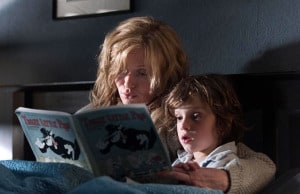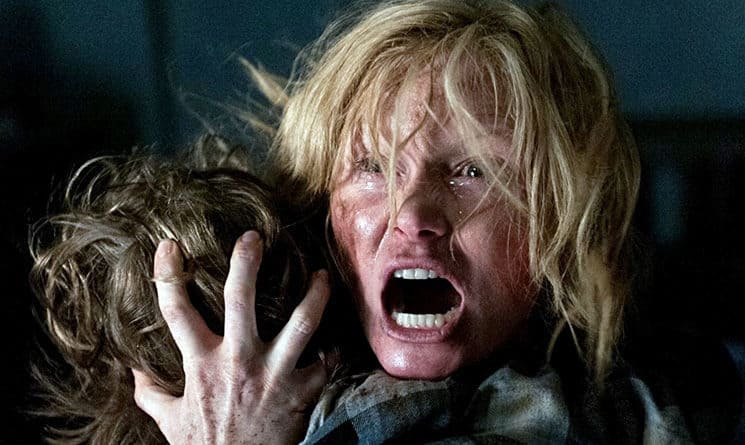2014, Not Rated, 94 minutes
The Babadook” is a very silly name for a very serious movie. This debut feature from Australian director Jennifer Kent is murky and alien and macabre in all the ways most modern horror films are not. If filmmaking is like “painting with light,” Kent paints with shadow, and with an impenitent resolve to envelope, overwhelm, and smother every brightness right out of her subject.
In this case, her subject is motherhood. Commonly portrayed as a house built of snuggles and strength and sainthood, Kent goes straight to the basement of maternal feelings: a cluttered, uncomfortable, taboo place where loss, resentment, disappointment, and anger wait hidden, poorly contained in mouldering heaps. A place where the unspeakable secrets are locked away, but continue to whisper. Despite what a good suburban mum may be compelled to tell her kids, Kent tells us, monsters are in fact very real and we make them ourselves. Worse, even, sometimes they look just like our children.
The film opens with Amelia (Essie Davies) being driven to the hospital to bear her first child. A tragic auto accident on the way brutally tears her loving husband away from her. We rejoin her six years later, left only with the dusty shell of her hopes for a happy home and a son to raise there by her own lonesome self.
Single motherhood is hard enough, but her boy Samuel (Noah Wiseman) is something of a handful. Which is to say, he’s an asshole, and nobody likes him. He’s both fascinated with and terrified by the unseen, obsessed with learning magic tricks and fairy tales about Big Bads on the other side of the door. He pinwheels between a worrisome fragility and an aggressive, occasionally menacing compulsion to protect himself and his mom against forces that only he seems to sense. On top of his simpering fear and screaming rages, the boy’s eyes are too big, and his teeth are too small, and there appears to be a few too many of them. Even when he smiles, there’s an unsettling threat something’s going to get snagged in there. He can be tender at times, and even lovable, but really only in the most entirely unlikeable way. He’s innocent in the same way a boney old cat that licks itself scabby and claws howling at medicine time is innocent. It’s not his fault that he’s a fiend; surely, he was just born that way. Amelia thinks it might be her fault. Her despair over this possibility is palpable, corroding her heart and stealing her sleep.
The lurker hovers just out of sight, an inky smudge with sharp twitching talons (and big eyes and little teeth), challenging them in hisses and croaks to look directly at it.
As if her life wasn’t quite dismal enough, there’s been something scratching at their doors, creaking along their floors. Perhaps the entity was invoked by the reading aloud of a harrowing pop-up book, one that appeared mysteriously on Samuel’s shelf, despite his repeated shrieks of, “Don’t let it in! Don’t let it in!” Or perhaps it had been with Samuel and Amelia all along. The lurker hovers just out of sight, an inky smudge with sharp twitching talons (and big eyes and little teeth), challenging them in hisses and croaks to look directly at it. Its presence is felt long before it’s been given a name, or the raggedy crown of its magician-ish top-hat breaks the surface of their home’s dark corners.
As in the early silent films that so clearly inform Kent’s vision, their household’s architecture, cold and obscured and of questionable right angles, is a graphic reflection of the eroding emotional state of its inhabitants. This crumbling and neglected no-man’s-land between the external and internal is an evocatively wrought battleground for a fight against a force that vows to pour itself into you, to spread out from under your skin. An extrusion of the darkness that already surrounds them, the spirit emerges, as towering as an adult might seem to a child and as ill-defined as a child’s drawing might seem to an adult.

As the pressure of its influence increases, Samuel’s quirks become truly dangerous, and Amelia’s already fractured fortitude starts to visibly disintegrate, it grows less and less clear exactly who this demon is haunting, or if it truly exists at all. Is it the manifestation of Samuel’s need for a father figure? Could it be his fear that his mom might find a replacement father for him? Is it Amelia’s abject inability to confront the loss of her husband? Or maybe the guilt she feels for her unutterable loathing of her own nasty little progeny? It easily could be all of these, or none, or something worse. Perhaps its source is inconsequential, but the consequence is profound. Try as they might to protect each other, the confusion, desperation and anguish the situation radiates proves that familial trauma can make those closest to us unqualified to offer any kind of real help. It is the wreckage of hope, the failure of promise, the thing no parent or child or human wants to admit. Calamity happens. Heartbreak exists. And once it’s there inside a family, it’s there to stay.
It says so right in that menacing pop-up book: “You can’t get rid of the Babadook.” The book wasn’t kidding, and neither is Kent. She breaks down boundaries to bring us to dreadful territory few else would and fewer still have. With her very first attempt, she’s created a positively terrifying and original ghost story that stands up with psychological powerhouses like “The Shining” and “Rosemary’s Baby” and “Let the Right One In.” “The Babadook” underscores the most horrific of truths: the most frightening monsters are the ones that go bump in the mind. We can’t keep them out because they’re already in the house; we’ll never truly be rid of them because they are, in a way, ourselves.

